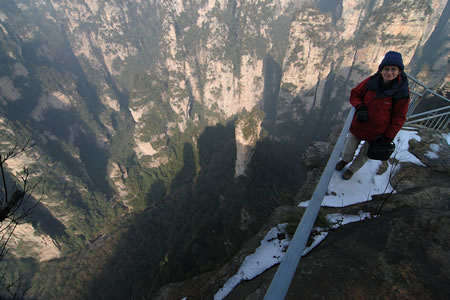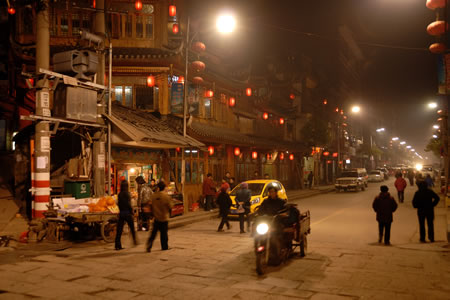English | Dutch |
|
| On our way through the karst provinces of China | |
Tunxi (China) to Liǔzhōu (China), Jan-01-10 / Jan-22-10 |
|
The year 2010 also started in China. We celebrated New Year’s Eve nice and cosy under the warm blankets of our hotel in Túnxī, due to a lack of decent heating in our room. A few days later, we travelled to Wùyuán. Wùyuán is a provincial town, which can serve as a base to explore the surrounding countryside. The landscape is beautiful and the villages with their old buildings are certainly worth a visit (See also the photo impression: Wùyuán - an example of rural China). The area has become a massively popular destination for domestic tourists in the last few years, which has resulted in many souvenir stalls and high entrance fees. Unlike in many other countries, the entrance fees are as high for domestic tourists as for foreigners. While we sometimes change our minds about visiting a certain sight because of the entrance fee are the Chinese tourists seldom put off by this. When arriving at the destination of their short holiday, they want to see everything that the destination has to offer. Domestic tourists are often curious about our “program” in a certain city or town. They can’t imagine spending their holiday in the same way as we do: just walking around with the two of us and just visiting the places that interest us. The sights of a town are merely a reason to get out on the streets, but normally are the things that we see in between those sights the most interesting. For the Chinese it is different. Leisure time is scarce in China and this means that domestic tourists want to spend it as efficient as possible. Often this means that they join a tour group. The guides are equipped with a microphone and a flag to make sure that nobody of the group misses a single sight. Nánchāng, provincial capital of Jiāngxī, is our next destination on our way through South-eastern China. Nánchāng isn’t a city that sees many tourists and the city in itself isn’t very attractive, but we will always have positive memories about our hotel. For the first time in weeks, we have a well heated place to recharge our battery after spending a day in the cold. In a daytrip from Nánchāng, we have tried to get a glimpse of the illustrious crane birds that winter at the nearby Póyáng lake (read also the article: Crane Kingdom). |
|
 |
|
One of the frightening viewpoints in Wǔlíngyuán Park |
|
| Via the city of Chángshā we travelled further to Zhāngjiājiè, a village at the border of the Wǔlíngyuán Scenic Area. The scenic area is a subtropical forest with immense karst peaks rising hundreds of metres into the sky. The concentration of peaks is higher then anywhere else in the world. This time, we aren’t put off by the entrance fee of nearly 25 euro, which entitles us to visit the park for two days. Park officials seem afraid that people are sharing a ticket which led to the instalment of fingerprint scanners. Such a decision would certainly lead to a lot of discussion in the Netherlands, but it isn’t an issue here. It’s our plan to use the first morning of our visit to walk the Huángshízhài trail that is known for its beautiful views. When entering the trail, we see that it is closed off with some ropes and a sign with some Chinese characters. After short deliberation we decide to forget the closure and to start our ascent of the mountain. We couldn’t have made a better decision! The views are tremendous, we see a lot of birdlife and we don’t have to share any of this beauty with someone else because of the official closure of the path. This is the first time in China that we can enjoy a famous nature sight without the noise of screaming and chattering Chinese tourists. Chinese tourists prefer liveliness over serenity, whether they are in a nature park or not. The higher we get, the more winter it gets. We didn’t see traces of snow or ice when we started our hike up the mountain, but after ascending several hundreds of metres we see ice drops hanging at the needles of the pine trees. After climbing some more metres, the snow is covering the branches of the trees and freezing rain is making the path as slippery as glass. While we only have 50 more metres to go to reach the top, we decide to turn around. It is just too dangerous. However, this doesn’t mean that we regret our decision to start the climb in the first place. The views that we enjoyed along the way were certainly worth the effort and the beauty of the winter weather near the top was a true bonus. We spend the afternoon walking the most popular route of the park: the Golden Whip Stream Scenic Route which follows a beautiful stream though a valley surrounded by karst peaks. It isn’t difficult to understand that this trail is the most popular among tour groups as it is a nice flat walk with many facilities that the Chinese love. They even made a path with all kinds of balancing stones to enhance your balancing skills. We enjoy watching the Chinese having a good time in this beautiful park. Ladies are walking on their high heels with their (fake) Louis Vuiton bags as if they are on the catwalk. Chattering is the main activity and nobody seems to be aware of the enormous karsts surrounding them. While the main attraction of this park is towering above them, everybody is looking at their mobile phone or at the balancing beams that they are trying to cross. We spend the second day of our visit of this park by walking a less popular route to the “Frightened of Height” viewpoint. It is a less hazy day, which enhances the views significantly. We climb 400 metres to be able to get a good view on the beautiful karst scenery. It is unbelievably beautiful and there isn’t another visitor in sight. At several places we look 400 metres down and the viewpoint “Frightened of Height” honours its name. While we normally don’t suffer from any fear of heights, Ivonne gets that strange feeling in her tummy at that place. The rusty iron bridge that we have to use to cross over a gorge to get to the viewpoint is probably also a reason for that. | |
 |
|
A street scene of photogenic Fènghuáng in the evening |
|
We regard the Wǔlíngyuán Scenic Area as the nicest nature park that we have seen in China so far. The combination of splendid views, many birds and the serene atmosphere on some of the paths make this a unique place on earth. Fènghuáng is the next destination and this is also a major attraction for domestic tourists. They are drawn to the nice (mainly over-restored) old buildings that stand next to an idyllic river. The old part of the city is attractive, but for us it isn’t really special. However, it is another good place to observe how the Chinese like to spend their holiday. One of the favourite activities is to be photographed in traditional clothes at the riverside. Food loving Chinese are well catered for by the many restaurants that are trying to alleviate their hunger for adventurous and ultra-fresh food. Therefore, there are piles of cages filled with strange kinds of rodents that we haven’t seen before, badgers, mandarin ducks but also the protected gold pheasants. When somebody wants to eat a certain animal, it is slaughtered on the spot. After spending several days in Fènghuáng, we travelled via Guìyáng to Wēiníng to try to see the endangered Black-necked Crane (See also the article: A little bit of traditional China). The number of cranes that we eventually saw was a bit disappointing, but our visit to the province Guìzhōu was certainly worth the time and the effort. This little visited province is the poorest province of the country, but also a very beautiful one with friendly people. While we have seen a polished version of rural China in Wùyuán, in Wēiníng we saw a purer form of it. The following destination is Guìlín, but to get there we have to backtrack to Guìyáng and travel from there via Liŭzhōu. The train trip from Guìyáng to Liŭzhōu takes more than 10 hours and we have boarded the train this morning. At the moment we are travelling in a so-called “hard-sleeper” train, where we are given a bed with a mattress, blanket and a pillow. In every compartment are 6 bunk beds in three tiers. When booking our train tickets we were too late to ensure ourselves from a lowest bunk bed, which means that we have to be content with our middle and top bunk bed. As the headspace of these beds is limited, we can’t sit on any of those beds. As we want to see something from the landscape that we are travelling through, this means that we have to sit on the small folding chairs in the aisle all day. Most other passengers don’t leave their beds the entire trip. Not strange at all, when you know that there isn’t heating in the train and the temperature only 9 degrees Celsius. Tonight we will spend the night in Liŭzhōu, from where we will travel to Guìlín tomorrow. We have high expectations about Guìlín. The famous Karst landscape is a true dream destination for most Chinese, so we can’t wait to see it for ourselves.
|
|
| <Previous weblog> | |